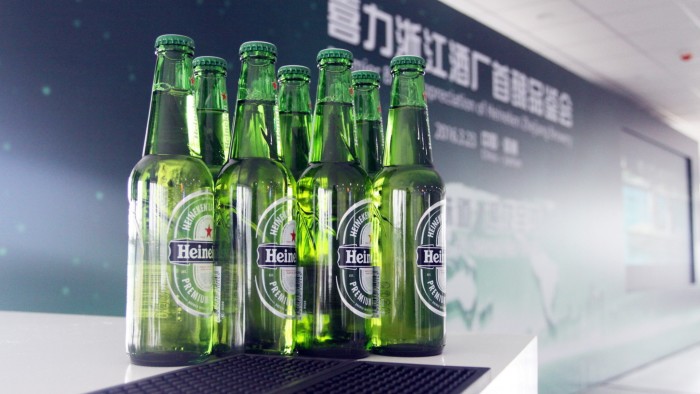Physical Address
304 North Cardinal St.
Dorchester Center, MA 02124
Physical Address
304 North Cardinal St.
Dorchester Center, MA 02124

China’s Western Customer Brands have long been consent with the expectation of low growth in the world’s second largest economy. However, the demand for Haynecin’s beer tells a different story.
In 2023, the sales volume for various brands of Dutch Leger Maker, including Amstell, has increased by more than 50 percent. Last year, the overall mainland China Bear market was shrinking, its fragments increased by about 20 percent below only 700MN liter – which is almost enough to serve everyone in the country.
HeinkenAn agreement has grown after an agreement with the China Resource Bear in 2018, which Heinchen took a part of the China Resources Bear and got royalty from the contract, while the mainland brand gave the state -owned group rights.
The procedure is pointing to the pocket of the opportunity for well -known foreign names in China’s rapidly developed consumer sector, even if they are saturated in extensive markets operated.
“This is a very healthy transaction relationship,” said Tistan Van Strien, director of Heineken’s relationship with China Resources Bear. “They need us and we need them.”
Burnstein’s analyst Yuan McLesh says Haincane’s growth rate is “undoubtedly”. “No other premium brand has talked about double digit.”
China’s overall beer market is declining. Sales have dropped to 4 to 5 percent last year in anxiety over consumer confidence.
However, for the China Resources Bear, whose sale has dropped by 2.5 percent in 2021, Haineken is a pick-mi-up.
Its deal with Heineken has given Dutch Bear in China for the initial 20 years, in exchange for a holding company’s partnership, he gives Heinchen an effective interest in China Resources Beer about 20 percent.

This legger, which was formerly sold in two southern provinces, was roll out all over the country. The growth was rapidly, in March, the Shanghai Formula assisted by sponsored events like Grand Prix, where there was a 500 ml serving for RMB 40 ($ 5.5).
According to the Morningstar, the average RMB 12-15 ($ 1.67-2.08) is served in China, although according to the Morningstar, the prices from the regions and bar shops are significantly changed.
Morningstar analyst Jackie Sang says Heinken has increased the “Distribution of China Resources Bear” to the development network.
China Resources Bear, whose local snow beer is the best seller in the country, using Haineken to push ChinaIts premium market – is often defined as beer that costs at least 20 percent higher than average.
“The overall beer amount in China is in the tendency to gradually decrease,” Sang said, which means China resources “had to go after the price increased to increase profit.”
The growth of heincane, from the lower base, is the opposite with other Western brands, which usually establish itself as a premium alternative in China.
Danish Bruer Carlsburg, which contains about 10 percent of China’s beer market, said that sales were less than 1 percent last year. Jacob Arup-AndersonChief Executive, last month, the market said that the market had “structurally decreased” for 15 years, but still had a “opportunity to grow enough”.

Unhealthy-Unlike Hynecain, he created a significant distribution network in China, owned by Budwizer also declined.
The competition between the two is “McLish in the context of the premium market in the context of” the winner-acceptance-all celebrity death match in the minds of many investors.
For more than an hour ago – around a global definition of affordable, Burnstein assumes, Burnstein’s average average Chinese now takes just 37 minutes of work for Chinese.
“We think in the 20 -year cycle, and this is the premium development cycle in China,” Van Strien said, who added that “premium beer really tends to make good” in the recession.
“You’re not talking about a huge capital expenditure for someone to be a great meeting for someone.”
For McLish, the China Resource technique creates the risk of “brand positioning” if the price of rapid expansion and its premium status has adverse effects.
China Resources Bear “No experience in creating a premium brand” but “If they take their time … growth rate never would have been faster”, he said.
Kevin Leeing, director of the investor relationship in the China Resources Bear, said there were some publicities but there was no “significant price reduction on any heincane product.”
There are other risks. With the prices of the Falling Shares of China Resource Bear, Heineken’s exposure managed to charge € 874 million dollars last year, even its own fragments increased sharply.
The Dutch agency does not reveal its dividend and royalty earning from the deal, but says that China is part of the resource beer and its royalities from China are equal to 6 to 7 percent of global net income.
Van Stines said that in the first quarter of this year, the fragments increased faster than 20 percent, and at the same time, its Amstel brand fragments doubled.
The deal with the China Resource was not a “planned last point”, Van Strien said. “The reality is, having local ownership is often the best thing for us,” he said.